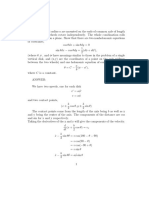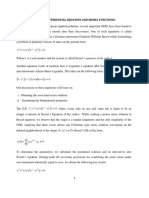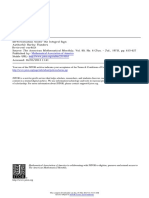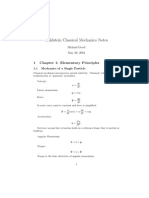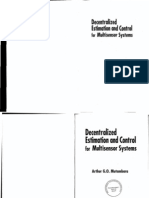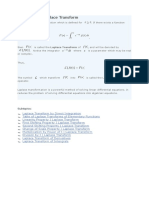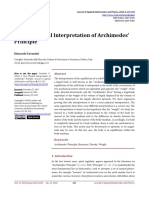100%(1)100% found this document useful (1 vote)
208 views20 pagesChapter 5 Vector Integration
Integration in vector analysis
Uploaded by
benjamin bosireCopyright
© © All Rights Reserved
We take content rights seriously. If you suspect this is your content, claim it here.
Available Formats
Download as PDF or read online on Scribd
100%(1)100% found this document useful (1 vote)
208 views20 pagesChapter 5 Vector Integration
Integration in vector analysis
Uploaded by
benjamin bosireCopyright
© © All Rights Reserved
We take content rights seriously. If you suspect this is your content, claim it here.
Available Formats
Download as PDF or read online on Scribd
You are on page 1/ 20
Chapter 5
ORDINARY INTEGRALS OF VECTORS. Let R(u) = Rj(u)
i + Ro(u)j + Ro(u)k bea vector depending
on a single scalar variable u, where (uw), Ro(u), Ro(u) are
Supposed continuous in a specified interval. ‘Then s
frie = fracrae + if o(u) du + wf roar
ite integral of R(u). If there exists a vector ‘S(u) such thet R(u) = £ (s(u)), then
du
fro = f ko du = Su) +e
whete ¢ is an arbitrary constant vector independent of u.
and u=6 can in such case be written
°
f wwe = ff dea = su) +e] = 80) — sya)
2
‘This integral can also be defined as a limit of a sum in a manner
tegral calculus.
is called an indefi
The definite integral between limits u=a
analogous to that of elementary in-
LINE INTEGRALS. Let r(u) = x(u)i + y(u)J + 2(u)k, where r(u) is the position vector of (,y,2), a
define a curve C joining points P, and P,, where u=u, and u=u, respectively.
We assume that C 1s composed of a finite number of curves for each of which r(u) has’a contin-
uous derivative. Let A(x,y,2) = A,i+4o4 + Ask be a vector function of position defined and con.
tinuous slong C. Then the integral of the tangential component of A along C from P, to P;, written as
t Ade = fre - fae + do dy + dgdz
, C lo
is an example of a line integral. If A is the force F on a particle moving along C, this line integral
represents the work done by the force. If C is a closed curve (which we shall suppose 1s a simple
closed curve, i.e, 2 curve which does not intersect itself anywhere) the integral around C is often
denoted by
fire = f Aydz + Agdy + Agdz
In aerodynamics and fluid mechanics this integral 1s called the circulation of A about C, where A
represents the velocity of a fluid.
In general, any integral which is to be evaluated along a curve is called a line integral. Such
integrals can be defined in terms of limits of sums as are the integrals of elementary calculus,
For methods of evaluation of line integrals, see the Solved Problems.
‘The following theorem is important,
82
VECTQR INTEGRATION : 83
$ ag, bs Sy $ bo,
R of space, defined by a; $x $ ag, by Sy $ bp
IEOREM. If A=V everywhere in a region
ms & $z$cz, where (x,y,z) is single-valued and has continuous derivatives in R,
then
Pe
1 f -A-dr is independent of the path C in R joining P, and P,.
1
2. f A-dt =0 around any closed curve C in R.
Insuch case A is called a conservative vector field and ¢ is its scalar potential.
A vector field A is conservative if and only if VxA=0, or equivalently A=V@. In such case
Acdt = A, dx + Azdy + Agdz = d@, an exact differential, See Problems 10-14.
SURFACE INTEGRALS.
Let S be two-sided surface, such as shown in the figure below. Let one
side of 5 be considered arbitrarily as the positive side (If S is a closed
Surface this is taken as the outer side). A unit normal n to any point of the positive side of S is
called a positive of outward drawn unit notmal.
Associate with the differential of surface
area dS a vector dS whose magnitude is dS and
Whose direction is that of n. Then dS~=ndS.
‘The integral \ ¥
[fos = fone
1s an example of a surface integral called the
flux of A over S. Other surface integrals are
Sox. Sores. Sos
where @ is a scalar function. such integrals can
be defined in terms of limits of sums as in ele.
mentary calculus (see Problem 17).
The notation
is
10 confusion can arise the notation f
a
To evaluate surface integr tegrals
egtals taken over
yendicular to the coordinat
nls 18 possible if any line per-_
oes not pose any teal problem since we +
8 restriction, ‘ bavi urfaces which do satis;
may also be used,
a4 VECTOR INTEGRATION
SOLVED PROBLEMS
2
1. If R(u) = (u—u?)i + 29 j — 3k, find (a) fr du and wf Riu) du.
(@) f woe i (uu?) + 2494 — ak] du
a + 1 f 28a + «f- 3 du
-# +e) + ices 2) + k(—3u +09)
6
Mot Sa - suk + est + eof + cok
- tuk +e
where ¢ is the constant vector cy1 + epj + egk.
2
(6) From (a), i Riu) du
2
J - Suk zac
2 HO A
UE By + 2s - scan + el — (e- H+ Ly - sae te)
Another Method.
ies R(u) du
=
i
-
Fe
=
+
2. The acceleration of a particle at any time 120 is given by
a = GF = ineosari ~ ssinzey + 160k
If the velocity v and displacement r are zero at
, find v and rat any time,
Intesrating, v = 1 f izcosare + 4 f-ssinarde + uf iecer
= Gsindei + 4cos2ej + BPR + cy
Putting v=0 when ¢=0, we find 0 = 01+ 4) + 0k +e; and q=—4J.
Then y = Gsingt + (4con2r—4J + ak
sotnat $f = Gsinaci + (Acosar—4s + Bik.
Integrating, r= 1 f osinzede + 4 f (ecoszr—ayar+ & f sitée
= -Scos2t + (2sinar—4ni + $Pk + &
Putting r=0 when ¢=0, © = —31 +0) + 0k + cp and co=31.
VECTOR INTEGRATION
‘Then ft = (3-3cos2ei + (2sin2e—4nj +
a
a2 Evaluate fa xq
4 an. = an
a :
fa fiaxya = afd.
Integrating, fasta : Sia Qt = axBee
# The equation of motion of a particle P of mass m is given by
Shere r As the position vector of P measured from an otigin 0, hy
and /(r) 1s a function of the distance of P from 0
fe) Show that rx $= ¢ where c 1s a constant vector
7
(6) Interpret physically the cases f(r) <0 and fir) >0
Ke) Interpret the result in (a) geometrically
(4) Describe how the resuits obtained re
is @ unit vector in the direction r,
Late to the mi
|
|
‘otion of the planets in our solar system,
(@) Multiply doth sides of -f = feyr,
by rx. Then
eae :
and Oren = 0
since r andr, are collinear and so rx 1, = 0. Thus
a fay
reGe =O and Sent). 9
a
ee = 0, where c inn constant vecter (Compare with Problem 3),
() It 07) <0 the acceleration ai? Ms direction opposite to r,: hence the force 1s directed toward 0 and
the particle is always attracted toward 0.
ete directed sway fiom Q and the particle is under fe influen
et inder the influence of a repulsive
fatce directed toward or away trom a fixed polat © and havis
Glstance r from O 1s called a central force. NE merle Gepe0dg oly onthe
(©) In time Ae the
Particle moves fror
Joining figure),
m M to N (see ad-
Pt out by the position
Ari hence the instan-
faneous tine rate of change in aren is
tke F
tin sex Ar yy de
aeme Ae = aT
where v is the instantaneous Velocity of the parti.
aixy
——<<11_~_—_—
VECTOR INTEGRATION
cle. ‘The quantity H = 4rx {© = grxy is culled the areal velocity. From pat (a),
Areal Velocity = B= rx $f = constant
Since r-H = 0, the motion takes place in a plane, which we take as the xy plane in the figure
(d) A planet (such as the earth) is attracted toward the sun according to Newton's universal law of
tion, which states that any two objects of mass m and M respectively are attracted toward each
with a force of magnitude F = MP, where r is the distance between objects and C 1s &
set of coord
constant, Let m and M be the masses of the planet and sun respectively and choos
nate axes with the origin O at the sun. Then the equation of motion of the planet is
ag Mm ér cu
Sia oe ee
‘assuming the influence of the other planets to be negligible,
According to part (c), planet moves around the sun so that its position vector sweeps out equal
‘areas in equal times. ‘This result and that of Problem 5 are two of Kepler’s famous three laws which he
deduced empirically from volumes of data compiled by the astronomer Tycho Brahe. These laws ent-
bled Newton to formulate his universal law of gravitation. For Kepler's third law see Problem 36,
5. Show that the path of a planet around the sun is an ellipse with the sun at one focus.
From Problems 4(c) and 4(d),
ny s -Hy
@ rey 5 am = h
Now r= rn, Sm so that
@) ih xy mx Ee) - Py
From (1), xm = -SHy xh = = GW nx (x
Zeorlina cen) = cu ge
ain euton (and ne fut hal BL «0 (tolom 8, Cater
eet too Mai Shieh. eh
But since
deexm = cw $e
Integrating, yeh CHAD
from which rom = en tee
« Chr temp © Gilet pend
where p is an arbitrary constant vector with magnitude p, and @ is the angle between p andr, .
aa, wenave A” = GMr + rpcos@ ant
VECTOR INTEGRATION 87
From analytical geometry, the polar equation of a conic
section with focus at the otigin and eccentricity € is
where o is @ constant. Comparing this Planet
"= 14 eco 0
with the equation derived, it is seen that the required
‘qrbit is a conic section with eccentricity € = p/GM.
"The orbit is an ellipse, parabola or hyperbola accord-
ing as € is less than, equal to or greater than one.
Since orbits of planets are closed curves it follows
that they must be ellipses.
Ellinse += 77¢ 0086
LINE INTEGRALS
if ‘Asdr from (0,0,0) to (1,1,1) along the follow-
6. If A = (3x?+6y)i — I4yzj + 20x27k, evaluate
ing paths
@z=Ly ‘
(b) the straight lines from (0,0,0) to (1,0,0), then to (1,1,0), and then to (1,1,1). |
(c) the straight line joining (0,0,0) and (1,1,1). |
(3x24 6y)1 — Ldyz f +20227k] (dei + dyj + dzk) j
—s
>
3 foostong = ye dy + 20x20 dz
points (0,0,0) and (1,1,1) correspond to 1= 0 and ¢=1 respectively. Then
1
yet slic = a (3:7 +6?) de — 1407) (8) dee?) + 200 (8) dc?)
yet a t
eS 2
ES.t = feu = we de + 600 ae
0
1:
= ficratroot) a = afar sel = s
to
Another Method.
Along C, A= 91-1455 + 207k and r=xb+yJtzk=c+e7§ +e and de=(1 +24) +3:2k)di
5 nde,
‘Then fa
iG
(921 — 180 $+ 2007 Wy. (4+ 269 + 367 ky de
fo
for aera
= Smee = G
(6) Along the straight line from (0
10,0) to (1,0,0) y=0, z= =
the Integral over this pat of the ath ig 7 T"0+87°0:de"0 while x varies from O to 1. Th
. Then
(a? +6(0))dz + 14(0)(0)
0) + 2
2 010) + 20x10}? (0) = [ ge? Ge
xo
Along the straight line from
(2.00) to
The te iste over ths pata be path
se
1,2=0,de=0, de
fe 0, d==0 while y varies trom 0 to 1
1.
2
(3QY"+ 60 — 1aycaydy + 20(1) (07 0
a0 0)
ee
88
VECTOR INTEGRATION
Along the straight line from (1,1,0) to (1,1,1), = 1, y=1, dx=0,dy=0 while z varies from 0 to 1.
‘Then the integral aver this part of the path is
% 2
(acay®+@¢a)) 0 — 1442) 2(0) + 20(1) 27 dz = i 2027 dz =
20 20
Adding, [ows sro B eB
(ec) The straight Line Joining (0,0,0) and (1,1,1) is given in parametric form by x=t, y=4, z=¢. Then
2
five = fi (Be? +60) de — 140) (0) de + 2000) (0)? de
re
= i (312+ 6r— 1417+ 200°) dt = fF ca—suts208 a - 3%
to oer
7. Find the total work done in moving a particle ina force field given by F = Szyi — 524 + 10x
along the curve x =17+1, y= 2:7, z=/° from pel to t=2. .
S
foo = Be dy + 10rds
ff s@merraten = 8(P)d(a?) + 1007 +1) e¢e°)
i (1a? + toe + 1277+ 3022) de = 308
from (0,0
8. If F = 3syi — y7J, evaluate i F-dr where C 1s the curve in the xy plane, y = 2:7
to (1,2). oc
‘Since the integration is performed in the xy plane (==0)
cantake r=
ae BS Stee) Ae
‘Taking the Limit of both sides as Ar-+0, we have 38 =h.
Similarly, we can show that
Then F = Rit hei + hk = $21 31+ Sx vp.
Ps
F-dr ts independent of the path C joining P, and Pa, then F is called a conservative field. It
follows tnt it F= Vo then F ts conservative, and conversely.
t
Proof using vectors. If the line integral is independent of the path, then
(earn) fers)
buys OT bed 8 if a fas
Me yi.) Kern)
By aitterentiation, 22 = F: Fed. put 9 = Vb-% go that (VF). a
Since this must hold irespective of 2€ , we have F= Vp.
11. (a) If F is @ conservative field, prove that curl F=Vx F=0 (i.e. F is irrotational),
(b) Conversely, if VxF~=0 (i.e. F is irrotational), prove that F is conservative.
(a) It F As & conservative field, then by Problem 10, F= Vd.
Thus curlF = Vx Vo = @ (see Problem 27(«), Chapter 4).
Lageah fice
@) 1 Vireo, tnen | 2 = 2] = 0 and tus
RR fh
O% _ ah | O% 0% _ oh
Wop Ge Soe 5 Oe 's Ome Ore
We must prove that F = Vp follows as a consequence of this.
‘The work done in moving a particle from (zs, yx, #:) to (x,y,z) in the force fleld F is
VECTOR INTEGRATION oh
if Reeyedde + Roeyaddy + ley )ds
ic
where C is a path Joining (2.7.23) and (x,y,z). Let us choose as a particular path the straight fine
this
Segments from (x, 71.) to (#,73, 23) to (x,y.%4) to (x,y,z) and call (+,y.2) the work done along
particular path. ‘Thon
= td
Stayt) = i RG yu rs) de +f
es
Fa(x,y,23) dy ell Fy(xiy,z) dz
Ms we
It follows that
x = Rey.)
y
ue
Then
2 2
Seon aes i weyayde
wos + [8
*@
= hea + "Bo
a
Ret Reg Aye = sb.y.5) + Rieya) — Racy.nu) = Fotey.2)
4
2 OR,
= Ryne) + le Bie ae Ce if Se eradds
% 1s
y ay, = OF,
= AGyee + ple Bearsoey + afi Be ene) dz
% a,
”
Aer + Renal + Rayay|,
%
Reyer) + Aley.2) — Foye) + Aleya) — Flyin) = Rosy)
ee i+ 3s. M, ave.
‘Thus a necessary And wuficlent condition fata eld F be conservative is that curl =Verr= 9.
Sepa ebave eae F = (2eyt2°)1| + 27) + See" in a conservative force field. (6) Find the sca-
{ar potential. (c) Find the work done in moving an object in this fleld from a
(a) From Problem 11, a nec
curl F = VxF = 9,
2,1) to (3,1,4).
a7 sad sufficlent condition that a force will be conservative in that
i i k
Noe rie eee eH.
ze Eek oye Jee . «
By + 2? 2 gg?
‘Thus F ts a conservative force field,
92 VECTOR INTEGRATION
(b) First Method,
OO, , ob),
By Problem 10, F= Vp or 3! va 4 +3, k= (ey +29) + 2x? f + 327k. Then
@) ae (OR
Integrating, we find from (1), (2) and (3) respectively,
b = xy + xx9 + foe)
ph mia + g(z.z)
d= xz? + A(x)
‘These agree if we choose f(y,z)=
be added any constant.
(ez) = 22°, A(z.y) =27y so that p = x*y +229 to which may
Second Method,
Since F is conservative, ih F-dr {s independent of the path C joining (x:,y1,2:) and (x,y,z).
Using the method of Problem 11¢5,
y
= i (xy ade + f xP dy sali Bez? dz
hy % *
. = 7 2
Seaaiey te) lea Araya me le
a Pes ene Sty eg ee
eee a ae as Bei ee ae 2
= ty te oy — aad = ay + 2 + constant
i BO ee oe en -
Third Method, F-dt Vob-ar et x ay + Sea dp
‘Then db = Rede = (dey te9)de + a2 dy + Ger2ds
= (ey de +2? dy) + (2% dx +3227 dz)
= d(e?y) + d(xz*) = d(a*y +22")
and @ = xy + 2° + constant.
Pe
(e) Work done = f Fed
an
Fe 2 2
Siereriae aed
I, -
e 2
A
Another Method.
= x?y + xz° + constant.
From part (b),
‘Then work done = (3,14) — P(1,-2,1) = 202.
VECTOR: INTEGRATION 93
and P, in a given
dr is independent of the path joining any two points 7,
3, Prove that if i
Ps
,
region, then f F-dr = 0 for all closed paths in the region and conversely.
Let P,AP)BP, (see adjacent figure) be a closed curve. Then a
f Pers et ra = f Fede + if Fedr
PAPBP, FylP, PBR
¢ » af Fedr — i Pdro= 0
RAP, ABP, A
‘since the integral from P, to P, along a path through 4 is the same as
that along a path through B, by hypothesis.
Fedr = f rae + f ree = Here
S = 0
ABP, Pe BBP, PIP,
a
PAP, ABP,
14. (a) Show that a necessary and sufficient condition that F, dx + F, dy + Fy dz be an exact differ-
ential is that VxF = 0 where F= Ait+Fj+ hk.
(b) Show that (y7z9 cosx ~4x"z) dx + 2:%y sinz dy + (3y?2” sinx —x*)dz is an exact dif-
ferential of a function p and find d.
(@) Suppose Fide + Pedy + dz = dp = ae
since x,y and 2 are independent variabl
ea =P
Creep ays
eee Fenisnicnn= 321. 26,, 2, Vo. Thus Ver = VxVb=0
an exact differential. Then
A
Conversely st VxF=0 then by Problem 1, F=
Fy dx + ydy + Fyds = dd, an eract differenti, iret no ideas iid tas
() F = 72" conx —42°s)1 + 29°, est
5 'y sinxd + (8772? sinx — x") a
mans. (8y?2? sin: Dk and VxF ts computed to be zero,
29 2 2 ‘
ieee et iy eine cy + (72? ain) de dp
By any of the methods of Problem 12 we find = 7:9 ging — «4
nz ~=*z + constant.
(A) + dm? = ‘
ie Velocities of the partic]
le at A and B respective
y.
tert eel tinct La Ae =
94 VECTOR INTEGRATION
@r
Fema=m$g- Then
B
Integrating, I, F-dr
MM
8
wt F=-Vo, if Fede
4
Then (A) — P(B) = ame - dmv and the result follows.
P(A) Is called the potential energy at A and $m? is the kinetic energy at A. The result states that
the total energy at A equals the total energy at B (conservation of energy). Note the use of the minus sign
in F= Vp.
WG. If p = dys", F= xyi-zj+x*k and Cis the curve x=17, y=2, 2=2° from t=0 to t=
evaluate the line integrals (a) ii pdr, (b) if Fxdr,
(@) AlongC, pb = yz? = 207)(20°F = 4°,
ros xityf#zk = P1+aj+ Pk, and
de = (Mi + 2 + 37k) ds. Then
2
foe = ii aP (et + 24 + 32h) de
2 Fo
i
=f wea +s f waa f ie PT
Oo. ‘Oo CF 5
(b) Along C, F=axyi— sits? = mi Pye en
Then Fxdr = (21 — 5 + Ak) x (ed + + 3) de
as
= fae -2 A] ae = (aP—atys + car's + cas*+20* a) at
2 2 x
a 2 .
wt free =P catiaye caf cue + [* area
(i ‘0 lo
Par
SURFACE INTEGRALS.
17. Give a definition of ins Acn dS over a surface S in terms of limit of a sum.
3
subdivide the area S into M elements of area AS, where p= 1,2,3,
ASp whose coordinates are (x,y, %). Define A(x, 7.29) = Ap
45, at P. Form the sum
‘M. Choose any point , within
1p be the positive unit normal to
Peak
VECTOR INTEGRATION %
Mu
Z rem ds
oat
where Ap-ny is the normal component
of Ap at Pp,
Now take the limit of this sum as
M-® in such a way that the largest di-
mension of each AS, approaches zero.
‘This limit, if it exists, 1s called the
‘surface integral of the normal compo-
nent of A over S and is denoted by
- Sf A-nds
18. Suppose that the surface S has projection R on the xy plane (see figure of Prob.17). Show that
pe - Sf ries
By Problem 17, the surface integral is the limit of the sum
u
a ZT Any ds,
pat
‘The projection of AS, on the xy plane is lea, A5,-x] or |ny-k| 45, which ts equal to Axy dy,
ds
sothat AS, = nat. Thus the sum (1) becomes
Ls
xy Oyg
@) 2 eT]
aoa
By the fundamental theorem of Integral calculus the limit of this
the largest Ax,
rp and Oy, approach zero is
ds dy
av fal
z
‘ ate
Strictly speaking, the result As, - —?%
: +" Tey 1s only aporoninately true but i can be shows on closer
»xamination differ from each other by infinite:
the Limite of (2) and (2) can in fact be shown equal
sum as
in such a manner that
‘and 80 the required result follows,
a of order higher than Any Ay,
9. Evaluate
i A-ndS, where A = —1aye
ns Sf fe A= 18:1 — 125 + aye and S ts that part of the plane
.
Be tdy +62 = 12 which Is located in the first octant,
BF tpn cars as nance
ar
VECTOR INTEGRATION
From Problem 17,
Sf eed an ee
[nek]
s g
To obtain m note Ehat a vector perpendicular to the surface 2x+3y +6z = 12 1s given by V2x+3y+6z) =
21 +34 + 6k (see Problem 5 of Chapter 4). Then a unit normal to any point of S (see fleure above) is s
7 io
vk = (214354 Saye = 8 Pera
‘Thus nk (yl + ad hk 7 and so [uk] = gaz dy.
36: — 96 +1
Also Am = (10114 +ayky (Bis Syrfyy « Sat
12~ 2 =
using the fact that x = 12—2*=°) trom the equation of S. Then
3
ae
ff mrss = [fant 0 ty = ff o-aneay
s g g Rg
‘To evaluate this double integral over R, keep x fixed and integrate with respect to y from y=0 (P in
12x
aad
tho figure above) to y = 12525 (@ inthe flee above); then Inogate with reapect fo» from 2=0 to
ly covered. The integral becomes %
*=6, In this manner R is comple
6 Pazes)/5 i a
Scores gan > pei eae ce
If we had chosen the positive unit normal n opposite to that in the figure above, we would have obtained
the result —24.
20. Evaluate oil A-ndS, where A = zi +xj— Sy?zk and S is the surface of the cylinder
if
x°+y?=16 included in the first octant between z=0 and z=5.
Project S on the xz plane as in the figure below and call the projection R. Note that the projection of
S on the xy plane cannot be used here. Then
VECTOR INTEGRATION
[fovs «foes
s
Anormal to x+y? = 16 is V(x? +y?) = 2xi+2yf.
‘Thus the unit normal to S as shown in the adjoining
figure, is
ES TES 7]
V(22F + yh 2
since x7+y%=16 on S.
= @itx}—a%k)- eter a
y= Ferd sr,
‘Then the surface integral equals
[faeae - Vinee ner = (cca:
(42 +8) dz
#0 x0
Deep)
90
21. Evaluate i nd5 where @ = Saye and S is the surface of Problem 20.
s
We have Jf gnds = ne Be
&
{nal
Using n= 2475 ay
= J a5 in Problem 20, this last integral becomes
5 ps =a
Be ee eiayn 2 a if f (2k txeV16—2" 4) de dz
20 x=0
a (” 6
eee fetter eet yar stole tons
22. It F = yl +(x—202)j—xyk, ev:
YE*(—2es)}—zyk, evatuate wii? (VxF)-n dS where 5 is the surface of the sphere
472427 =a above the xy plane =
1
i k
Wine: |o. B28
ey 8
y x-2e
= xityi—ak
sy
Anomal to x?+y?+2? =a? ig
Barer sis
VECTOR INTEGRATION
‘Then the unit normal n of the figure above is given by
= Mi+aseme — sityserk
, Vax? tay? +42" e
since x? +7? +2? = a7,
The projection of $ on the xy plane 4s the region R bounded by the circle x?ty2e a?, 20 (see flee
ure above). Then
f Ware HY
je
4
LJ (Vxr)-n aS
8 2
Sf ce +y4— 20h). (2! ty +k, ea
R
* VERE a, ious
= : re eae dy dx
ya-Va
salne the tact that x = v= =a
Bi
sino
re
:
Take a strip of
the adjoining figure,
OLUME INTEGRALS he
Planes 42+2y+2~5, 2-9,
uate the inte,
} Let = 45x%y and let ¥ denote the c
losed region bounded by the
70, ==0. (a) Express Sffex
7
as the limit of a sum. (6) zval al in (a),
100 VECTOR INTEGRATION
(a) Subdivide region V into M cubes having volume
AK, = Ax, Ay, On, k= 1,2,.0.,M as indicated *
in the adjoining figure and let (x,74,2,) be @
point within this cube. Define D(%.94,%) =
Dy. Consider the sum
x
a LD 4%
he
taken over all possible cubes in the region.
‘The limit of this sum, when N~© in such a
manner that the largest of the quantities Al,
will approach zero, if it exists, is denoted by
aii dV. It can be shown that this limit
Y
is independent of the method of subdivision if
is continuous throughout V.
In forming the sum (1) over all possible cubes in the region, it 1s advisable to proceed in an order
ly fashion. One possibility is to add first all terms in (1) corresponding to volume elements contained
in a column such as PQ in the above figure. This amounts to keeping x, and y, fixed and adding over
all z's. Next, keep x, fixed but sum over all y,'s. This amounts to adding all columns such as PQ
contained in a slab RS, and consequently amounts to summing over all cubes contained in such a slab.
Finally, vary x,. This amounts to addition of all slabs such as RS.
In the process outlined the summation is taken first over z,'s then over y,'s and finally over x's.
However, the summation can clearly be taken in any other order.
(®) ‘The ideas involved in the method of summation outlined in (a) can be used in evaluating the integral.
Keeping = and y constant, integrate from z=0 (base of column PQ) to z = 8—4x—2y (top of column
PQ). Next keep x constant and integrate with respect toy. This amounts to addition of columns having
bases in the xy plane (z= 0) located anywhere from R (where y= 0) to S (where 4x+2y=8 or y=4—2x),
and the integration is from y=0 to y=4—2r. Finally, we add all slabs parallel to the yz plane, which
amounts to integration from == 0 to x= 2. The integration can be written
es pst
eal f asey de dy dx of f inter mere
x= y=0 -z=0 x=0 yo
2
= 4s f dta-me ae -
Bs
Note: Physically the result can be interpreted as the mass of the region V in which the density >
varles according to the formula = 45x7y.
26. Let F= %zi-xjt+y7k. Evaluate SS F dV where V is the region bounded by the sur-
7
faces x=0, y=0, y=6, 2=27, z=4.
‘ ting from 2=x? to z=4 (base to top of
‘The region ¥ is covered (a) by keeping x and y fixed and integrat
column PQ), (6) then by keeping x fixed and integrating from y~=0 to y~=6 (R to S in the slab), (e) finally
integrating from <=0 to x=2 (where z=x" meets z= 4). Then the required integral 1s
VECTOR INTEGRATION 101
Bee
if f if (Beet — xj +7) dz dy dx
x=0 y=o 2tx?
zens 2 rb pw 2rere
se fea fT pune
Beet 0 0/2? 0 2
0 x!
= 128i — 24) + sea
Me
Required volume
. ae
hi (@2—x2)dy = 160°
tp ( yas a
So
/
You might also like
- Chapter 6 Divergence, Stokes, Greens Theorem100% (1)Chapter 6 Divergence, Stokes, Greens Theorem20 pages
- JanMyrheim Kompendium - Klassisk.feltteoriNo ratings yetJanMyrheim Kompendium - Klassisk.feltteori323 pages
- Bessel'S Differential Equation and Bessel FunctionsNo ratings yetBessel'S Differential Equation and Bessel Functions57 pages
- Krane, Halliday and Resnick - Physics (5th Ed., Vol. 2)No ratings yetKrane, Halliday and Resnick - Physics (5th Ed., Vol. 2)695 pages
- Problems of The 2 International Physics Olympiads (Budapest, Hungary, 1968)No ratings yetProblems of The 2 International Physics Olympiads (Budapest, Hungary, 1968)5 pages
- Modern Physics Kenneth S. Krane Kindle & PDF FormatsNo ratings yetModern Physics Kenneth S. Krane Kindle & PDF Formats123 pages
- Goldstein Classical Mechanics Notes: 1 Chapter 1: Elementary PrinciplesNo ratings yetGoldstein Classical Mechanics Notes: 1 Chapter 1: Elementary Principles149 pages
- Decentralized Estimation and Control For Multisensor Systems100% (3)Decentralized Estimation and Control For Multisensor Systems126 pages
- Solutions To Problems in Jackson, Classical Electrodynamics, Third EditionNo ratings yetSolutions To Problems in Jackson, Classical Electrodynamics, Third Edition14 pages
- Integral Vector Calculus: Learning Outcomes100% (1)Integral Vector Calculus: Learning Outcomes33 pages
- Instructor's Solution Manual of Electrodynamics in GriffsNo ratings yetInstructor's Solution Manual of Electrodynamics in Griffs253 pages
- A New Physical Interpretation of Archimedes Princ-1No ratings yetA New Physical Interpretation of Archimedes Princ-19 pages
- Streamline Coordinates in Fluid MechanicsNo ratings yetStreamline Coordinates in Fluid Mechanics6 pages
- PDF PPT Mathematical Physics Tensor Unit 7No ratings yetPDF PPT Mathematical Physics Tensor Unit 743 pages
- Force of Foot On Floor (Pushing Backward) Force of Floor On Foot (Reactive Force On Foot's Push)No ratings yetForce of Foot On Floor (Pushing Backward) Force of Floor On Foot (Reactive Force On Foot's Push)4 pages
- Lecture Notes (Chapter 4.5 Gauss and Stokes Theorem)No ratings yetLecture Notes (Chapter 4.5 Gauss and Stokes Theorem)5 pages
- Classical Dynamics of Particles and Systems Instructor S Solution Manual 5th Edition Stephen T. ThorntonNo ratings yetClassical Dynamics of Particles and Systems Instructor S Solution Manual 5th Edition Stephen T. Thornton86 pages
- PHYS 510 A: Mathematical Methods of Physics Homework #1 Kristin Kathleen Creech Lassonde100% (1)PHYS 510 A: Mathematical Methods of Physics Homework #1 Kristin Kathleen Creech Lassonde35 pages






